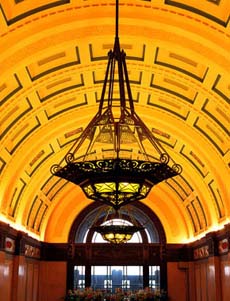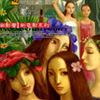Shanghai art deco in photo
By Wang Jie (Shanghai Daily)Updated: 2006-12-29 09:04
 Shanghai was-and still is-a treasure trove of art-deco buildings,
concentrated in the former French Concession, and photographer Deke Erh has been
documenting the modernist style since the early 1980s, writes Wang Jie.
Shanghai was-and still is-a treasure trove of art-deco buildings,
concentrated in the former French Concession, and photographer Deke Erh has been
documenting the modernist style since the early 1980s, writes Wang Jie.
Old Shanghai is a glamorous legend, and Shanghai of the 1930s is an especially popular theme nowadays in fashion, architecture and decor.
Many people have glimpsed old Shanghai through the novels of Eileen Chang, one of Shanghai's most beloved female writers.
While many of the particular backdrops of her creations have gone, there is much that remains: the lobby of an old apartment, the patterns on the lobby ceiling or even the building itself.
These glimpses of the city in the 1930s, "Shanghai Art Deco," a photo exhibition, is under way at the Deke Erh Art Center.
The exhibition coincides with the publication of Erh's 320-page book "Shanghai Art Deco." He has been photographing old buildings, houses and villas in the former French Concession since the early 1980s.
"This volume has witnessed a long period of my life from youth to middle-age, a life filled with both illusions and tough realities," the Shanghai-based photographer says of his largest published work.
He doesn't know what compelled him to continuously photograph the city.
"I cannot explain it myself," he says. "Staring at the art-deco desk lamp and the now-silent radio, I was lost in blank amazement. If my father were alive he would find it strange that I would take photos of those articles and of street scenes so ordinary in his early years."
More than 20 years ago, while strolling from street to street to photograph the legendary buildings of Shanghai, he gradually fell in love with the style without really knowing much about it.
At first he was just fascinated by buildings in the art-deco style, but subsequently he came to realize that its spirit was also encoded in numerous pieces of furniture, electric appliances and utensils.
But what is art deco?
It grew out of art nouveau, a school popular at the turn of the 20th century, noted for its simplicity, with particular stress on geometric lines and colors.
It made its full-fledged appearance in Paris in the 1925 Exposition Internationale des Arts Decoratifs et Industriels Modernes.
Drawing inspiration from primitive African arts as well as those of the Orient, art deco incorporates elements of cubism, bauhaus and futurism. It soon swept the world and ultimately reached Shanghai.
Buildings here exemplify the common art-deco motifs, zigzags, porthole windows, stylized floral and animal designs compounded with Chinese elements such as clouds, mountains over waves, ancient coins, Taoist octagrams.
Other elements like rays of sunlight at dawn and shafts of lightning were also adopted. Many art-deco buildings in Shanghai were designed by the best-known British firm, Palmer & Turner. The Hungarian architect Ladislaus Hudec and his French counterpart Paul Veysseyre were in the forefront of this new style.
For example, the Customs House on the Bund appears in one of the pictures. Although the building is mostly in the classical style, architects Palmer & Turner introduced some art-deco elements into the clock tower.
Completed in 1927, it became the first building on the Bund whose tower featured the modernist style.
Others may be more attracted to Eddington House.
This building with a broad vertical focus, flanked by the projecting horizontal lines of the long balconies, has the added whimsy of thin triangular windows popping out of the end units of the upper floor. Apart from its art-deco charisma, its former writer resident Chang stirs melancholy recollections. In fact, Chang wrote about it in several books.
Shanghai is a treasure trove of art-deco buildings, says Erh. But unlike other big art-deco centers - such as Miami Beach, Florida and Melbourne, Australia - they are not concentrated in one area. They are scattered all over the city, with the more stunning apartment buildings and villas in the former French Concession.
Date: through December 31, 9am-5pm
Address: Bldg 2, 210 Taikang Rd
Tel: 021-64150675
|
||
|
||
|
||
| Eating out:
Lebanese fare provides pleasant surprise
Bars&Cafes: Amnesia Ibiza Weekend&Holiday: Shanghai art deco in photo Shopping: Ring in the New Year What's on: After 10 years, Ukulele says 'Farewell' |

